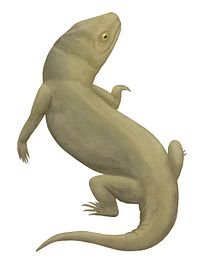- Owenetta
-
Owenetta
Temporal range: 260.5–250 Ma Mid Wuchiapingian - early Induan
"Owenetta" kitchingorum Scientific classification Kingdom: Animalia Phylum: Chordata Class: Sauropsida Subclass: Parareptilia Order: Procolophonomorpha Suborder: Procolophonia Family: Owenettidae Genus: Owenetta
Broom, 1939Species - O. rubidgei Broom, 1939 (type)
Owenetta is an extinct genus of basal procolophonian parareptile. Fossils have been found from the Beaufort Group in the Karoo Basin of South Africa. Although most procolophonians lived during the Triassic, Owenetta existed during the Wuchiapingian and Changhsingian stages of the Late Permian as well as the early Induan stage of the Early Triassic. It is the type genus of the family Owenettidae, and can be distinguished from other related taxa in that the posterior portion of the supratemporal bears a lateral notch and that the pineal foramen is surrounded by a depressed parietal surface on the skull table.
Contents
Species
The type species of Owenetta is O. rubidgei. It is known from several skulls, but no postcranial skeleton. It was described in 1939 from a partial skull found from the Late Permian Cistecephalus Assemblage Zone of the Beaufort Group[1]. Several other localities, all from the overlying Dicynodon Assemblage Zone, have yielded the remainder of the known specimens.
The naming of a new species in 2002, O. kitchingorum, extended the temporal range of Owenetta into the Early Triassic, meaning that the genus had survived past the Permian–Triassic extinction event[2]. This new species was considered distinct from the type species based on features found from three nearly complete specimens that were present from the Lystrosaurus Assemblage Zone. Found in 1968, the first material of O. kitchingorum was a small block containing two skeletons in close proximity to one another (although at the time they were thought to be of the type species)[3]. These skeletons provided much of the information used to distinguish O. kitchingorum from the type species. O. kitchingorum differed from O. rubidgei in that it possessed small postparietals on the posterior edge of the skull table and that the maxilla held no more than 20 teeth, some of which were caniniform. The best preserved specimen seems to be a subadult individual on the basis of features of the skull table.
A year after the new species of Owenetta was named, a paper proposed that it should be assigned to its own distinct genus, although a new name is yet to be provided[4]. A more recent paper also supported this polyphyly[5]. If this is the case, Owenetta is once again temporally restricted to the late Permian, and most likely died out at the end of the period as a result of the mass extinction event.
Later that year the short limbed lizard Colubrifer campi, named in 1982 from a specimen found from the Early Triassic Lystrosaurus Assemblage Zone, was reassigned to the genus Owenetta. Based on a skull nearly identical to those known of Owenetta, it appears that the animal was almost certainly a procolophonian of that genus. This suggests that Owenetta did in fact survive the mass extinction event at the end of the Permian.
Phylogenetics
When Owenetta was first named and described, it and other procolophonians were thought to be within Cotylosauria, a group that comprised what was believed to be the most primitive of reptiles. Cotylosauria has since been renamed Captorhinida, which is now thought to be a paraphyletic group anapsids and anapsid relatives. Owenetta and other procolophonians are now known to be within the subclass Parareptilia. It has later been placed within the family Nyctiphruretidae, but is currently placed within the family Owenettidae, of which it is the type genus[6][7][8].
The well preserved, nearly complete specimens of Owenetta can be helpful in phylogenetic analyses of procolophonians and the parareptiles, which have recently undergone many great revisions. Although the postcranial skeleton is only known from immature individuals, comparisons can be made with related taxa such as Barasaurus, which is known from both immature and mature specimens, that resolve this morphology issue. Owenetta has been used in some phylogenetic analyses to uphold the traditional theory that the procolophonians were the ancestors of turtles[9], although it now seems that turtles have evolved from parieasaurids[10] or even sauropterygians[11].
References
- ^ Broom, R. (1939). A new type of cotylosaurian, Owenetta rubidgei. Annals of the Transvaal Museum 19:319–321.
- ^ Reisz, R. R. and Scott, D. (2002). Owenetta kitchingorum, sp. nov., a small parareptile (Procolophonia: Owenettidae) from the Lower Triassic of South Africa. Journal of Vertebrate Paleontology 22(2):244-256.
- ^ Gow, C. E. (1977). Owenetta in perspective. Palaeontologica Africana 20:115–118.
- ^ Modesto, S. P., Damiani, R. J., Neveling, J. and Yates, A. M. (2003). A new Triassic owenettid parareptile and the Mother of Mass Extinctions. Journal of Vertebrate Paleontology 23(3):715–719.
- ^ Modesto, S. P. and Damiani, R. (2007). The Procolophonoid Reptile Sauropareion anoplus from the Lowermost Triassic of South Africa. Journal of Vertebrate Paleontology 27(2):337-349
- ^ Lee, M. S. Y. (1995). Historical burden in systematics and the interrelationships of parareptiles. Biological Reviews 70(3):459-547.
- ^ deBraga, M. and Reisz, R. (1996). The Early Permian reptile Acleistorhinus pteroticus and its phylogenetic position. Journal of Vertebrate Paleontology 16(3):384-395
- ^ Säilä, L. K. (2008). The osteology and affinities of Anomoiodon liliensterni, a procolophonid reptile from the Lower Triassic Buntsandstein of Germany. Journal of Vertebrate Paleontology 28(4):1199-1205
- ^ Reisz, R. R. and Laurin, M. (1991). Owenetta and the origin of turtles. Nature 349:324-326.
- ^ Lee, M. S. Y. (1997). Pareiasaur phylogeny and the origin of turtles. Zoological Journal of the Linnean Society 120:197-280
- ^ Rieppel, O. and deBraga, M. (1996). Turtles as diapsid reptiles. Nature 384:453-455.
External links
- Owenetta in the Paleobiology Database
Categories:- Parareptiles
- Prehistoric reptiles of Africa
Wikimedia Foundation. 2010.
